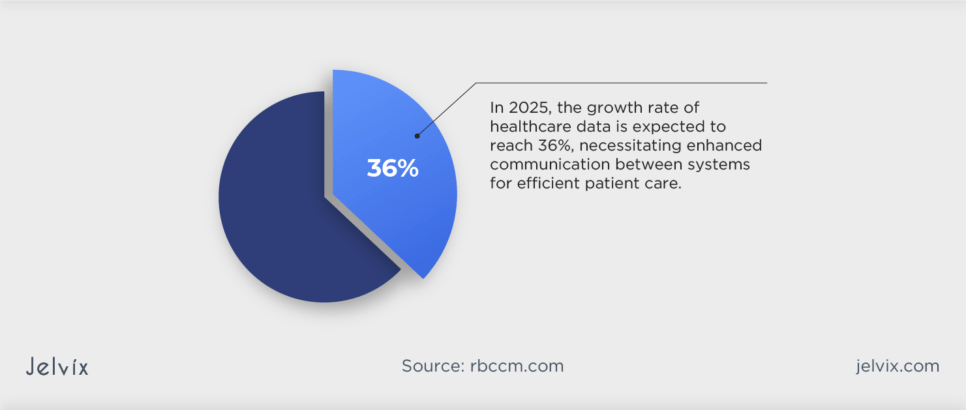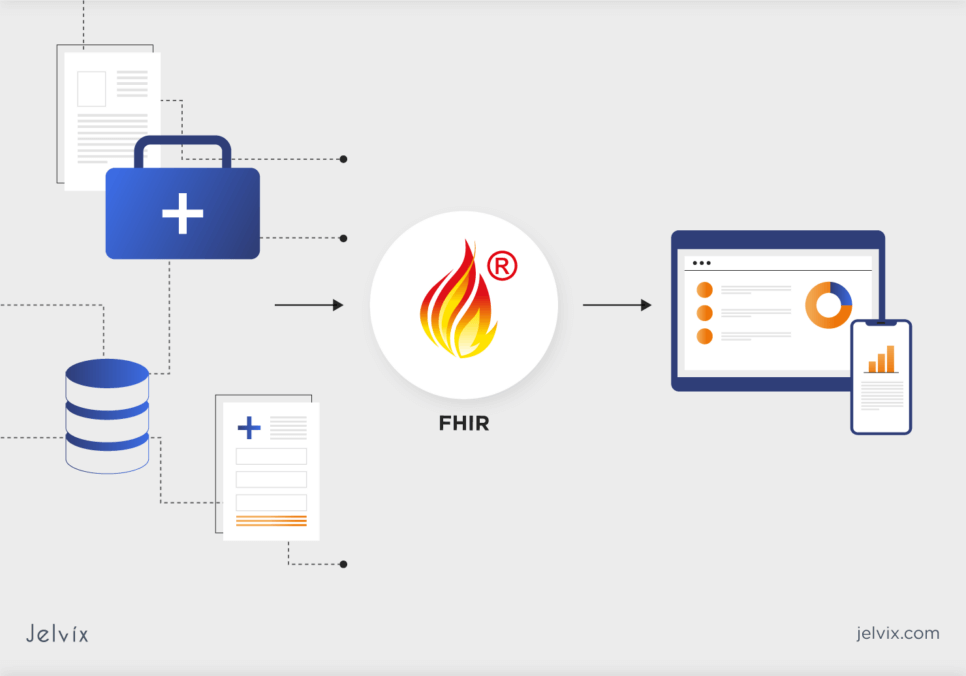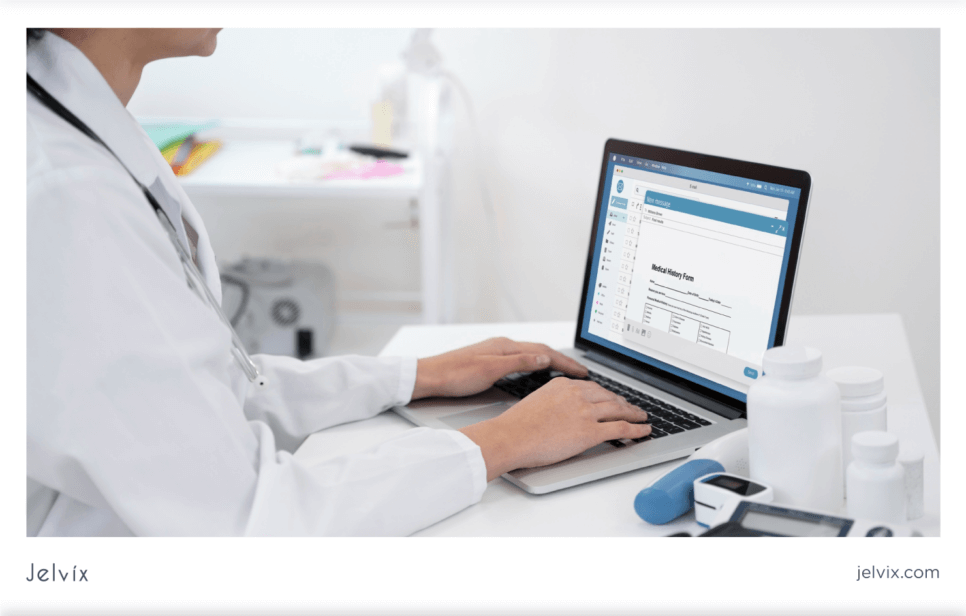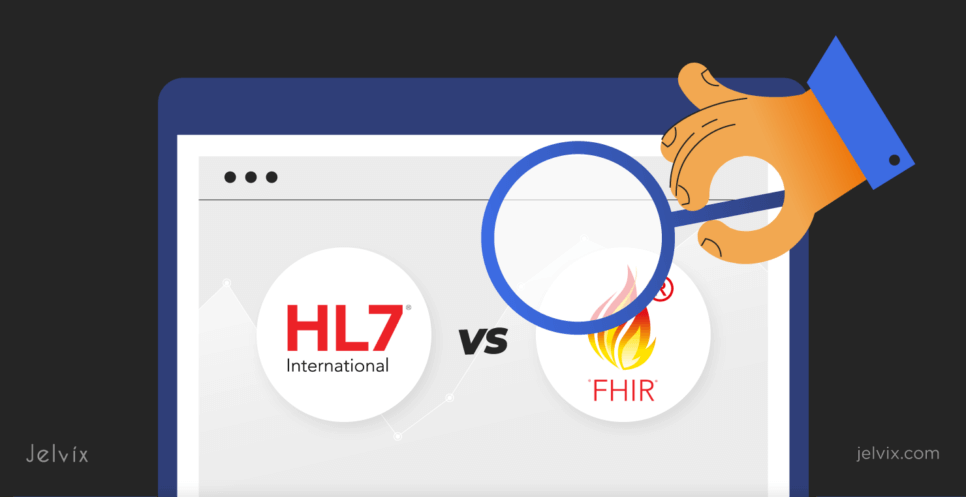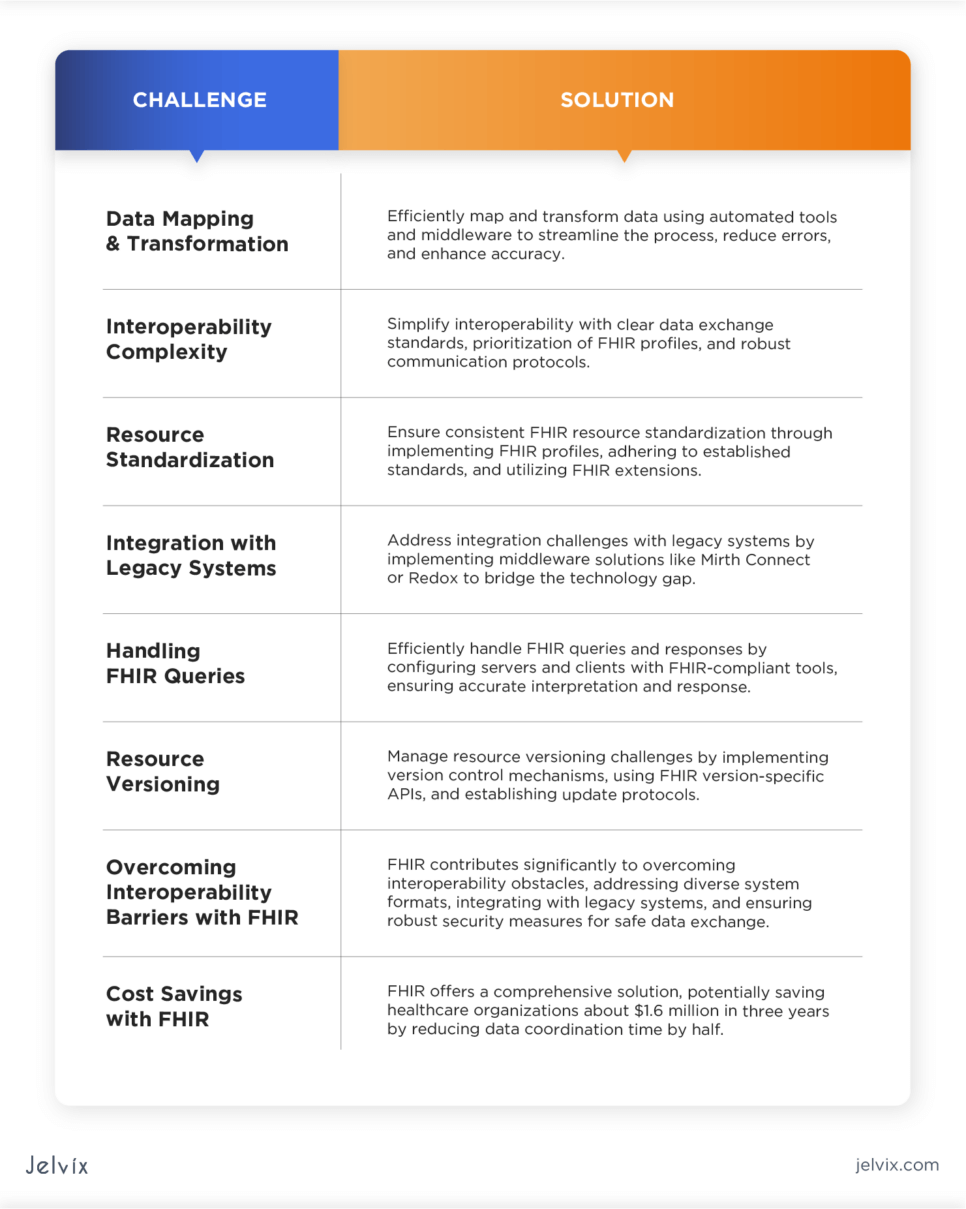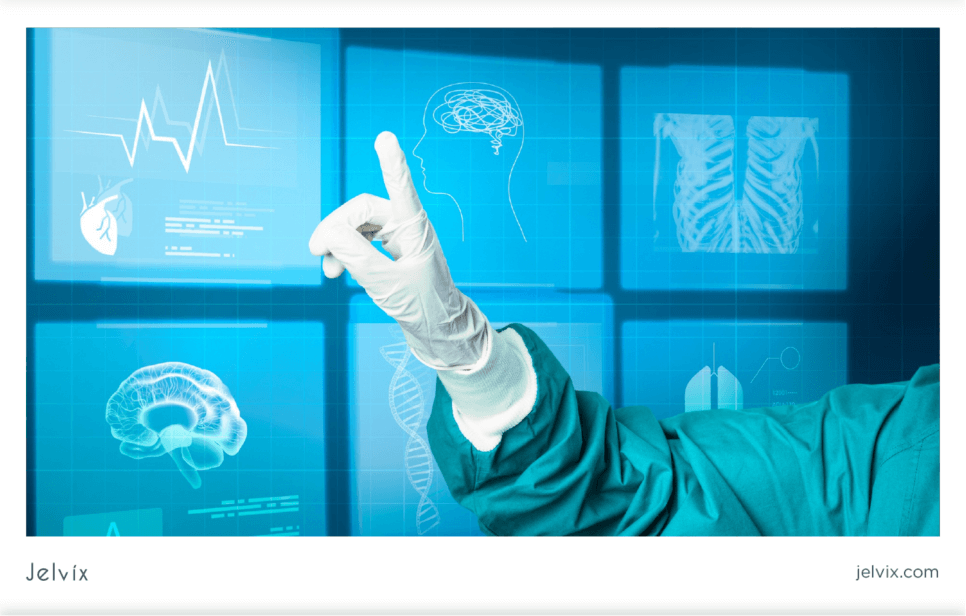The volume of healthcare data is growing. According to RBC Capital Markets, about 30% of the world’s data is generated by the healthcare sector. Looking ahead to 2025, the compound annual growth rate of healthcare data is projected to hit 36%. This expanding volume of information requires improved communication between different healthcare systems to efficiently deliver patient care.
In December 2022, the U.S. federal government proposed new rules that involved using FHIR to create an API ecosystem based on open industry standards throughout the healthcare value chain.
If you are a healthcare provider or vendor seeking to address the challenge of interoperability with the use of standards, such as FHIR, keep reading. In this article, the Jelvix team talks about FHIR benefits, challenges, and implementation recommendations to help you set up interoperability among your healthcare systems.
Understanding Fast Healthcare Interoperability Resources
Fast Healthcare Interoperability Resources (FHIR) is a standard for exchanging healthcare information electronically. Developed by HL7, FHIR is designed to enhance interoperability and simplify the exchange of health data between different systems, allowing seamless sharing of health information on various devices.
FHIR exposes individual data elements as services, simplifying the exchange of healthcare information. It represents a significant step in making health data sharing more efficient and fast.
By adhering to FHIR standards, healthcare providers, systems, and applications can achieve a higher level of compatibility, making it easier to share, access, and use health data. FHIR’s practical interoperability promotes a more connected and collaborative healthcare ecosystem, ultimately enhancing the effectiveness of healthcare delivery.
The Importance of FHIR in Modern Healthcare Data Exchange
FHIR plays a crucial role in addressing the longstanding challenges of data exchange in healthcare. Its importance lies in its ability to provide a standardized and efficient way for different healthcare systems to communicate and share data.
Enhancing Interoperability
FHIR’s modular and resource-oriented architecture fosters clinical interoperability among disparate systems. Electronic health records, medical apps, and other health-related platforms can seamlessly exchange data, ensuring a unified view of patient information.
Patient-Centric Care
FHIR promotes patient-centric care by enabling the secure and efficient exchange of patient data. This ensures that healthcare providers have access to comprehensive and up-to-date information, leading to informed decision-making and improved patient outcomes.
Streamlining Development
The use of RESTful APIs in FHIR simplifies the development process for healthcare applications. Developers can leverage existing web standards, reducing the complexity of integration and accelerating the creation of interoperable solutions.
Facilitating Innovation
The flexibility offered by FHIR allows healthcare organizations to adapt quickly to technological advancements and evolving industry needs. Developers can easily integrate FHIR into their applications, fostering innovation in healthcare solutions and services.
Historical Context and Evolution of FHIR Development
FHIR’s origin is rooted in the demand for a flexible and standardized method for healthcare interoperability. The objective was to establish a standard that aligns with contemporary technology, promotes straightforward implementation, and encourages innovation in the exchange of healthcare data. Introduced by HL7 (Health Level Seven International) in 2014, FHIR has seen iterative updates to adapt to changing healthcare requirements.
From HL7 to FHIR: Key Development Milestones
FHIR has experienced several milestones in its development that collectively showcase its journey from its inception to becoming a dynamic and influential standard in healthcare interoperability:
- HL7 foundation: Health Level Seven International laid the foundation for healthcare interoperability standards. Versions 2.x and 3.x were predecessors that set the stage for the evolution toward FHIR.
- Web-based technology adoption: FHIR embraced modern web-based technologies, including a RESTful protocol over HTTP. This move represented a departure from traditional healthcare standards and contributed to FHIR’s flexibility and ease of implementation.
- Interoperability Focus: FHIR prioritized interoperability by design, making it easier for different healthcare systems to exchange information seamlessly. Its flexible architecture accommodated various healthcare scenarios and promoted collaboration.
- Extensibility: FHIR was designed with extensibility in mind, allowing for easy integration with existing healthcare systems. This feature enhanced its adaptability to different healthcare contexts, supporting scalability and customization.
- Direct data exposure: FHIR introduced a shift from document-centric approaches to directly exposing discrete data elements as services. This approach streamlined data retrieval and manipulation, contributing to an efficient and accessible system.
Core Concepts of FHIR
The core concepts of FHIR revolve around its modular and resource-centric approach for efficient health data exchange. By embracing these concepts, FHIR provides a modern and adaptable framework for promoting interoperability across different healthcare systems.
Resources
FHIR organizes health information into resources, which are the basic building blocks. Resources represent discrete pieces of data, such as patients, medications, or observations. Each resource has a unique URL and can be accessed independently.
Modularity
FHIR emphasizes modularity, allowing for easy integration of specific resources. This modular structure enables flexibility in creating tailored solutions based on the specific needs of healthcare applications.
RESTful API
FHIR uses a RESTful (Representational State Transfer) API, making it web-friendly and easily accessible. This API enables seamless communication between different healthcare systems, applications, and devices.
Interoperability
FHIR’s design prioritizes interoperability, aiming to facilitate smooth data exchange across diverse healthcare environments. The standardized format and modular structure enhance the ability to share information efficiently.
Profiles
FHIR supports profiles that define constraints and extensions to resources, enabling customization based on specific use cases or implementations. Profiles help ensure consistency in data exchange while accommodating variations in requirements.
Terminology Services
FHIR incorporates standardized terminology services to ensure a common understanding of clinical concepts. This contributes to semantic interoperability, enhancing the meaningful exchange of health information.
Versioning
FHIR incorporates versioning to manage changes in resources over time. Each resource has a unique URL, allowing retrieval of specific versions and facilitating accurate tracking of historical data.
Querying and Search
FHIR supports querying and search functionalities, enabling efficient retrieval of relevant information. The system uses RESTful principles, allowing queries based on resource attributes, and ensuring flexibility in data retrieval.
Security and Privacy
FHIR prioritizes security and privacy by implementing robust measures. It includes features like authentication, authorization, and secure communication protocols to safeguard sensitive health data and maintain patient privacy.
Explore strategies and solutions for enhanced data exchange in the healthcare landscape, and learn how to boost healthcare interoperability.
FHIR Resources and Structures
As was noted earlier in this article, FHIR organizes health information into standardized structures known as resources. The FHIR framework includes a diverse set of resources, each designed to capture specific aspects of health data.
FHIR APIs and Their Role in Data Exchange
FHIR relies on a Representational State Transfer (REST) architecture for its Application Programming Interface. This RESTful API allows the exchange of healthcare information using standard HTTP methods. Developers leverage FHIR resources and interact with them through RESTful endpoints, making it a user-friendly and widely adopted approach.
By adopting a RESTful API architecture and using the Open API 2.0 standard, FHIR promotes simplicity and efficiency in data transactions. This web-friendly design enhances interoperability, making health data easily accessible and shareable across various platforms.
FHIR Profiles and Extensions
FHIR profiles and extensions empower healthcare stakeholders to tailor the FHIR to their specific needs to reach interoperability and accommodate the diversity of healthcare data.
FHIR Profiles
Profiles in FHIR define constraints on FHIR resources, allowing tailored implementations to meet specific use cases. They provide a way to define and share how resources should be structured and used within a particular context or domain. FHIR profiles ensure interoperability by offering a standardized framework while accommodating variations to address diverse healthcare scenarios.
FHIR Extensions
Extensions in FHIR enable the addition of custom data elements to standard resources. They allow organizations and systems to incorporate specific information that might not be covered by the core FHIR standard. Extensions enhance the adaptability of FHIR to capture specialized data relevant to unique healthcare requirements. This extensibility promotes the broad relevance of FHIR across various healthcare contexts.
FHIR Interoperability in Practice: Real-World Use Cases
FHIR interoperability comes to life through real-world use cases. From EHR integration to innovative applications, these use cases illustrate the transformative power of FHIR in addressing ongoing healthcare challenges.
Examples of FHIR Facilitating Data Exchange
The examples below demonstrate how FHIR serves as a foundational standard for diverse data exchange scenarios in healthcare, promoting interoperability, data liquidity, and improved healthcare outcomes.
Electronic Health Record Integration
FHIR is commonly used to facilitate interoperability between different EHR systems. For instance, a patient’s health information stored in one EHR system can be seamlessly exchanged with another system using FHIR standards. This ensures that healthcare pros have access to comprehensive and up-to-date patient records, regardless of the EHR platform.
Remote Patient Monitoring
FHIR enables efficient data exchange in remote patient monitoring applications. Devices that collect real-time patient data, such as wearable devices or IoT sensors, can use FHIR standards to transmit this information to healthcare providers. This facilitates continuous monitoring of patient’s health conditions and timely interventions based on the exchanged data.
Health Information Exchange
FHIR plays a pivotal role in health information exchanges, where different healthcare organizations share patient information securely. FHIR’s standardized data allows seamless communication between disparate systems, promoting coordinated care and avoiding duplicative tests and procedures.
Mobile Health Apps
mHealth applications leveraging FHIR standards can exchange health data with other systems, creating a connected healthcare ecosystem. For example, a medication adherence app using FHIR can share data with a patient’s primary care provider, ensuring that medication information is consistently updated and accessible.
Public Health Reporting
FHIR is used in public health reporting scenarios where timely exchange of health data is crucial. For instance, during disease outbreaks, FHIR facilitates the efficient sharing of relevant patient information with public health authorities, enabling swift response and containment measures.
How to Implement FHIR: Best Practices and Recommendations
FHIR implementation involves configuring an FHIR server, mapping and converting data to adhere to FHIR standards, and developing RESTful APIs for seamless data exchange. Security measures, effective query handling, and system scalability are critical considerations.
10 Steps to Set Up a FHIR Server and Clients
Setting up a FHIR server and clients involves creating the infrastructure to enable FHIR-based data exchange. The Jelvix team offers to follow 10 steps to successfully set up a FHIR server:
- Define the infrastructure requirements by assessing hardware and software prerequisites, ensuring compliance with security and privacy standards;
- Select a FHIR server implementation that aligns with organizational needs, such as HAPI FHIR or Smile CDRl;
- Install and configure the chosen FHIR server software, setting up databases and ensuring proper connectivity;
- Establish FHIR server endpoints for data access, configuring security protocols and authentication mechanisms;
- Develop or select FHIR client applications for data exchange, ensuring adherence to FHIR standards and protocols;
- Conduct thorough testing to validate the interoperability of the FHIR server and clients, addressing any issues related to data exchange and system integration;
- Map existing healthcare data to FHIR standards and implement conversion mechanisms to transform data into FHIR-compatible formats;
- Implement robust security measures for the FHIR server, including access controls and encryption, and regularly update security protocols;
- Set up logging mechanisms to track FHIR server activities and implement monitoring tools to ensure system health and performance;
- Create documentation outlining FHIR server and client configurations, and conduct training sessions for stakeholders on using FHIR for data exchange.
By following these steps, organizations can establish a robust and interoperable FHIR infrastructure, enabling seamless data exchange in the healthcare ecosystem.
Data Mapping and Conversion to FHIR Standards
Data mapping and conversion to FHIR standards involve aligning existing healthcare data formats with FHIR’s structured model. This process ensures accurate representation and exchange of data. Healthcare organizations should identify and map data elements from their sources to FHIR structures, followed by conversion to the FHIR-compliant format.
Using tools can streamline this process by standardizing data exchange and improving overall healthcare collaboration. Widespread tools include SnomedInfo Health Intersections, which aid in mapping data to SNOMED CT codes, and HAPI FHIR, an open-source Java-based library supporting FHIR implementations. Additionally, platforms like HealthShare by InterSystem offer comprehensive FHIR capabilities, including data mapping and conversion functionalities.
Handling FHIR Queries and Responses
FHIR supports a RESTful API, allowing clients to send queries to FHIR servers and receive well-structured responses. Queries can be customized based on parameters such as patient identifiers, date ranges, or specific data elements. FHIR responses are typically in JSON or XML format, providing a standardized and easily interpretable format for data retrieval.
Handling FHIR queries involves utilizing the FHIR RESTful API to communicate with FHIR servers. Here’s a simplified guide:
- Constructing queries: define the query parameters based on the desired information (e.g., patient data, diagnostic reports). Use FHIR’s structured query capabilities to specify details such as date ranges or specific data elements;
- Sending queries: use HTTP methods to send queries to the FHIR server’s endpoint. Include the constructed query parameters in the URL to request specific data;
- Authentication and authorization: implement secure authentication mechanisms to ensure authorized access to patient data. Use appropriate security measures such as OAuth tokens or API keys;
- Handling responses: receive FHIR responses in JSON or XML format. Extract relevant information from the response body based on the original query;
- Error handling: implement error-handling mechanisms to address potential issues, ensuring robust and reliable query execution;
- Data processing: process the retrieved data according to the application’s requirements. Integrate the queried information into the healthcare system for seamless data exchange.
FHIR Implementation Challenges and Solutions
Implementing FHIR involves navigating through specific challenges that require strategic solutions to ensure successful integration.
Data Mapping and Transformation
Efficiently mapping and transforming data to comply with FHIR standards is a nuanced process. Challenges may arise due to variations in data formats, structures, and semantics across different systems. Automated tools and middleware can streamline this process, reducing manual errors and enhancing the accuracy of data transformation.
Interoperability Complexity
With the necessity to exchange information fast, things are getting more complicated. Interoperability complexity arises from the diversity of healthcare systems, each with its unique data models and communication protocols. Clear data exchange standards, prioritization of FHIR profiles, and the establishment of robust communication protocols are essential strategies to simplify interoperability and promote seamless data exchange.
Resource Standardization
Ensuring consistent FHIR resource standardization involves defining how specific resources should be structured and used within a particular context or domain. Challenges may arise in defining and sharing these standards across diverse healthcare scenarios. Implementing FHIR profiles, adhering to established standards, and utilizing FHIR extensions for additional customization are key strategies to address this challenge.
Integration with Legacy Systems
Legacy systems often present integration challenges due to outdated technologies and data models. Middleware solutions, such as Mirth Connect or Redox, act as adapters, bridging the gap between legacy systems and FHIR-enabled applications. By implementing middleware, organizations can facilitate smooth communication, ensuring data exchange without compromising the functionality of existing systems.
Handling FHIR Queries
Efficiently handling FHIR queries and responses is crucial for seamless data exchange. Challenges may arise in configuring servers and clients to accurately interpret and respond to queries. Using FHIR-compliant servers and clients, along with proper configuration, ensures a robust system capable of handling queries effectively.
Resource Versioning
Resource versioning challenges emerge when managing updates and changes to FHIR resources while maintaining backward compatibility. Implementing version control mechanisms, utilizing FHIR version-specific APIs, and establishing protocols for handling resource updates are critical strategies to address versioning challenges and ensure data consistency.
Overcoming Interoperability Barriers with FHIR
The implementation of FHIR contributes significantly to overcoming interoperability obstacles. FHIR addresses diverse healthcare system formats, ensuring seamless data exchange. Its adaptability integrates with legacy systems, overcoming infrastructure challenges. Robust security measures ensure safe data exchange, overcoming privacy concerns.
In summary, FHIR provides a comprehensive solution for improved interoperability that could save healthcare organizations about $1.6 million in three years by reducing data coordination time by half.
FHIR in the Context of Healthcare Regulations
Adopting FHIR for data exchange requires a comprehensive understanding of compliance considerations to ensure the secure and privacy-conscious exchange of healthcare information.
HIPAA Compliance
FHIR implementation must align with the privacy and security provisions outlined in HIPAA to safeguard protected health information (PHI). Encryption, access controls, and audit trails are essential components to ensure HIPAA compliance.
GDPR Alignment
FHIR data exchange involving European patients requires adherence to GDPR principles. Healthcare organizations need to ensure transparent data processing, obtain explicit patient consent, and implement measures to enable data portability.
Interoperability Standards
FHIR’s commitment to interoperability supports compliance by enabling standardized data exchange. Conforming to interoperability standards, such as HL7, HIE, and SNOMED-CT, ensures that healthcare systems can communicate seamlessly while meeting regulatory requirements.
Emerging Trends and Innovations in FHIR
As the healthcare industry progresses, FHIR remains a driving force, impacting innovations in the exchange of healthcare data. FHIR holds the potential to reshape interoperability, ultimately improving patient care and revolutionizing medical processes.
FHIR R4 Standardization
FHIR Release 4 (R4) signifies a significant leap in standardization, offering enhanced data exchange capabilities. The broader adoption of FHIR R4 is anticipated to result in improved interoperability and streamlined communication across diverse healthcare entities.
Patient-Centric Interoperability
FHIR places a strong emphasis on patient-centric interoperability, empowering individuals with greater control over their health data. Future innovations in FHIR are likely to focus on providing patients with seamless access to their health information, contributing to increased digital patient engagement.
Integration with Artificial Intelligence
The convergence of FHIR with AI holds immense potential for optimizing data analysis and decision-making in healthcare. The integration of AI capabilities with FHIR is expected to unlock valuable insights from vast datasets, leading to more personalized and efficient healthcare interventions.
FHIR in IoT Healthcare Solutions
The IoT is gaining prominence in healthcare, and FHIR is poised to play a crucial role in this domain. FHIR’s adaptability and data exchange capabilities make it well-suited for integrating diverse healthcare IoT devices, contributing to more seamless data sharing and analysis.
Expansion of FHIR Implementation Guides
To accommodate diverse healthcare scenarios, FHIR implementation guides are expected to expand. These guides provide specific instructions on using FHIR in different contexts, promoting consistent practices, and ensuring interoperability across various healthcare settings.
How Custom Healthcare Solutions Support FHIR Interoperability
Custom healthcare solutions contribute to FHIR interoperability by providing tailored features and capabilities that align with the FHIR standard. They facilitate data mapping, support modular integration, and ensure a user-friendly experience within an existing healthcare ecosystem.
At Jelvix, we combine domain expertise with technological advancements to deliver custom healthcare solutions tailored to your unique needs. Our experienced team understands the difficulties of FHIR implementation and navigates the complexities of healthcare IT with precision.
Reach out to our team for a conversation about your specific interoperability objectives. Let’s explore how our expertise can drive your healthcare organization into a connected and efficient future.
Looking for a Tech Partner?
Unlock seamless data exchange with our team of expert software developers.


